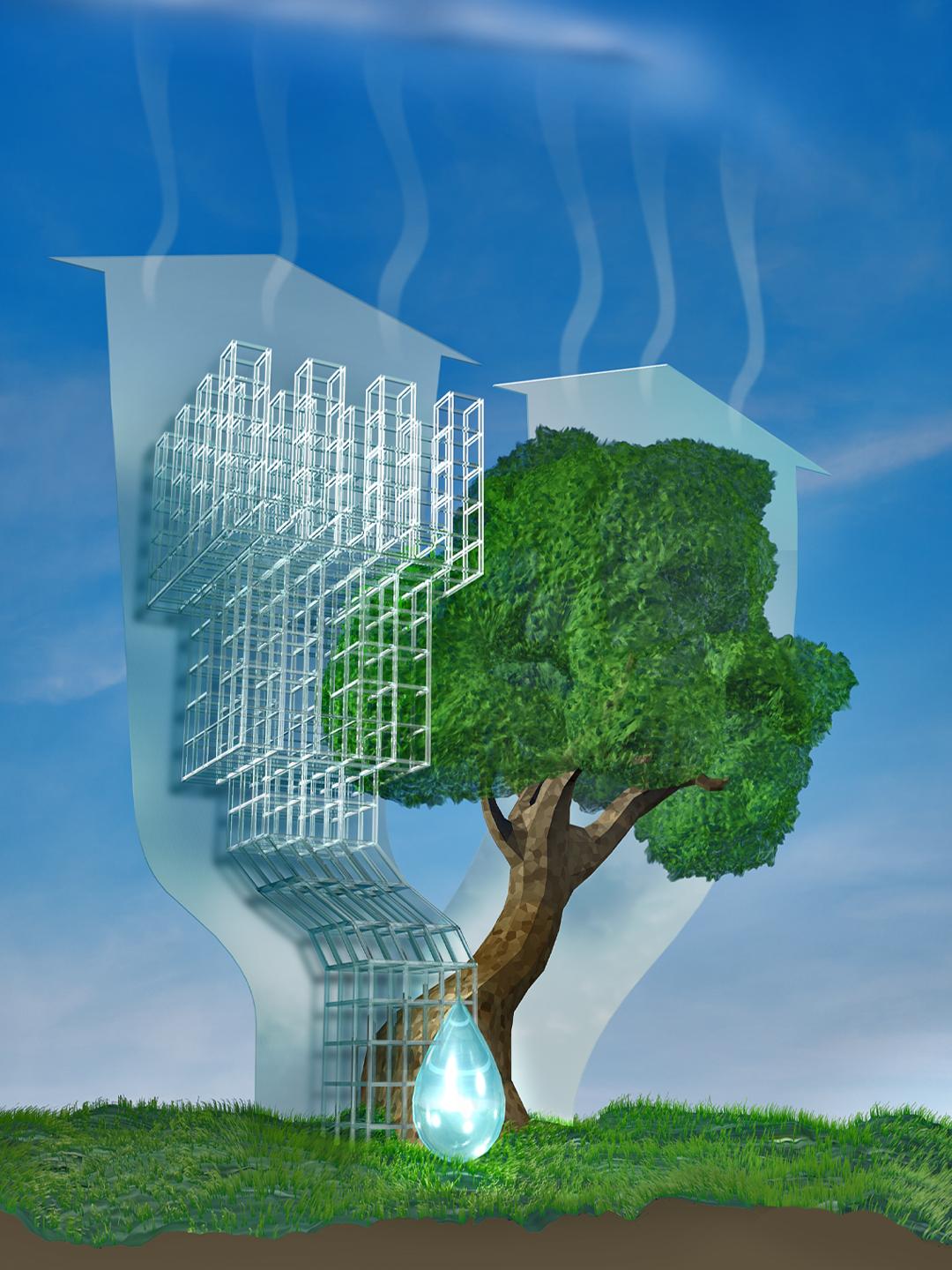
Copying the wonders of nature – and surpassing them
With the participation of DESY, the BlueMat Cluster of Excellence is investigating how different nanoporous materials interact with water. Among other things, the scientists hope to produce electricity from silicon and water using artificial sponges – an approach that is unrivalled in its simplicity and sustainability.
Sponges are one of the best-known examples of bionics – an evolutionary solution discovered by nature that has been copied by human technology to make use of its functional advantages. Sponges can absorb large amounts of water because, in addition to the holes that are visible, they also have countless smaller, invisible pores in which the water is stored.
Such materials are described by experts as nanoporous: they are riddled with pores and channels just nanometres across. Human beings use these not only to soak up liquids, clean things, and store or filter liquids, but also to take advantage of the extremely large surface area offered by such materials: “Surface areas the size of entire football pitches are contained within the volume of a sugar cube, which is very useful for many applications because a larger surface area often equates with a greater effect,” says Patrick Huber, head of the Institute for Materials and X-ray Physics at the Hamburg University of Technology and the “High-resolution X-ray Analytics of Materials” group at DESY. Hence, such materials are also used for batteries or sensors and as catalysts in the chemical industry.
“Blue materials” for a more sustainable future
Within the new Cluster of Excellence “BlueMat: Water-driven Materials”, which is being funded by the federal and state governments, Huber’s team wants to carry out research into completely new applications for nanoporous materials in connection with water. To do this, they will be collaborating with numerous partners, under the leadership of the Hamburg University of Technology, including the University of Hamburg, DESY and the Helmholtz Centre Hereon. Because such materials develop completely new properties as a result of different interactions with water. The X-ray source PETRA III and its planned update PETRA IV will play a key role in investigating these properties and interactions.
For example, the development process could conceivably lead to smart windows that filter out different types of radiation, depending on the time of day, thereby controlling the temperature in a room. Or to glass displays which you can write on using an infrared laser that vaporises the water they contain.
One particularly promising area of application is energy technology: nanoporous materials can produce electricity when they come into contact with water. This would constitute a new form of hydrovoltaics, producing electricity in the same way as photovoltaics, but using water instead of sunlight. Rather than generating electric power in the traditional way, using water power to drive turbines, hydrovoltaics makes use of microscopic phenomena such as wetting or evaporation.
Electricity from sand and water
In the context of BlueMat, the researchers aim to develop an electrically conducting, nanoporous material that generates electricity when soaked in water – and once it has dried, the cycle starts all over again. “This hydrovoltaic approach has two major advantages,” explains Huber. On the one hand, it uses simple, readily available and inexpensive raw materials and processes. The nanoporous material can be produced by self-organising processes like corrosion and by 3D printing. It can be made from normal silicon, which is obtained from quartz sand, for example. And drying can be performed using very low-threshold waste heat from industrial processes or computers, for example. “Strictly speaking, you don’t even need heat, just dry air,” says Huber. “The heat just makes the drying process more effective.”
The point is that neither complex materials or mechanisms nor heat radiation of a particular quality are needed. “For us, the complexity lies not in the chemistry, but in the geometry of the material,” says Huber.
“For us, the complexity lies not in the chemistry, but in the geometry of the material.”

Trees as a model
And once again, nature serves as a model. Huber uses the example of a tree: at school, every child learns that trees are able to transport water from the ground all the way to the highest branches using narrow capillaries just nanometres wide – without a mechanical pump, mainly thanks to the capillary effect of the narrow tubes and the negative pressure in the leaves, caused by the evaporation of the water – a process known as transpirational pull.
However, in geometric terms, trees have a lot more to offer: the structure of their fibres is so cleverly arranged at the cellular level that they can withstand enormous mechanical loads, despite being composed simply of hydrogen, oxygen and carbon. “The sugars have a hierarchical, porous structure,” explains Huber. “Cells join together to form filaments, which form bundles, which form fibres. The tree implements complex architectural principles on different scales, and in doing so achieves tensile strengths, for example, that we have previously only been able to reach using steel.”
The roots of trees display even more finesse: aquaporins – special proteins containing tiny channels – ensure that only the nutrients the tree needs are able to enter, while other substances are kept out. “In addition to their size, this also works via their electrical charge,” says Huber. Aquaporins are positively charged and thus repel protons, but they allow neutral water molecules to pass through, even though they are much larger. “Trees are masters of nanofluidics,” says Huber. The 2003 Nobel Prize in Chemistry was awarded for structural studies that shed light on these processes.
BlueMat aims to artificially produce materials of a similar geometric complexity. And the new hydrovoltaic material would be a perfect example: water or an aqueous electrolyte, such as a simple saline solution, penetrates the pores of a nanoporous silicon electrode and induces a charge, which becomes attached to the walls of the material. Thanks to the material’s huge surface area, the charge carriers quickly add up to produce a considerable amount of electricity, which can be drawn off and put to use. The preliminary goal of the project is to achieve 10 kilowatt hours per cubic metre. This is roughly enough to power an entire household or a small workshop.
The simplest form of recharging
Such quantities are particularly interesting in the light of the very simple mechanism for “recharging” the silicon electrode – by allowing it to dry. “Simple waste heat is sufficient for this, and when the water evaporates it also cools its surroundings; so this form of power generation could be ideal for large data centres, which are needed more and more urgently in our modern, computerised and increasingly AI-controlled world,” says Huber. The material supplies electricity while at the same time cooling the computers, and the computers provide the heat required to dry the material after wetting.
A lower-threshold area of application could be autonomous sensors that would require neither a power supply nor a battery. Whenever it rains, the sensor would produce its own energy and transmit its readings. The most obvious application would be rain sensors, but other types are also conceivable.
Surpassing nature with PETRA IV
In order to put such ideas into practice, however, the researchers still need to overcome various technical hurdles, which require an even more detailed understanding of exactly how the water molecules interact with nanoporous silicon. “The X-ray microscope PETRA III, which we use for this purpose, allows us to observe how channels just 2.5 micrometres wide fill up with water,” reports Huber. Ideally, however, the researchers would like to track every single water molecule, each of which is just 0.25 nanometres in size, 10,000 times smaller than the channels. How does it behave inside the channels? How does it interact with the walls? What exactly happens when substances dissolved in the water salt out and clog the channels over time? “In studies using PETRA III, we can only extrapolate this kind of detail, but not film them directly. However, PETRA IV will have a much higher resolution, meaning we can film events at the nano level and assess much more precisely how we need to modify our material in order to achieve optimum results.”
Correspondingly precise investigations will also allow the 3D printing of nanoporous silicon to be optimised. Under a microscope, it is possible to observe how the silicon powder melts under the laser, cools down and how the atoms join up again. This knowledge may allow the researchers to control and accelerate the process more specifically and choose the arrangement of the silicon atoms such that the resulting material contains hardly any defects.
PETRA IV would therefore enable researchers like those at the BlueMat Cluster of Excellence to uncover many of nature’s secrets. And in such detail that it will finally be possible to imitate natural processes, which are often more efficient and sustainable than those used in engineering. It will become possible to copy the wonders of nature. “But that’s not all,” says Patrick Huber. “In individual cases, we may be able to use artificial intelligence to find configurations that work even better, for example because they are more durable.”

Trees as a model
And once again, nature serves as a model. Huber uses the example of a tree: at school, every child learns that trees are able to transport water from the ground all the way to the highest branches using narrow capillaries just nanometres wide – without a mechanical pump, mainly thanks to the capillary effect of the narrow tubes and the negative pressure in the leaves, caused by the evaporation of the water – a process known as transpirational pull.
However, in geometric terms, trees have a lot more to offer: the structure of their fibres is so cleverly arranged at the cellular level that they can withstand enormous mechanical loads, despite being composed simply of hydrogen, oxygen and carbon. “The sugars have a hierarchical, porous structure,” explains Huber. “Cells join together to form filaments, which form bundles, which form fibres. The tree implements complex architectural principles on different scales, and in doing so achieves tensile strengths, for example, that we have previously only been able to reach using steel.”
The roots of trees display even more finesse: aquaporins – special proteins containing tiny channels – ensure that only the nutrients the tree needs are able to enter, while other substances are kept out. “In addition to their size, this also works via their electrical charge,” says Huber. Aquaporins are positively charged and thus repel protons, but they allow neutral water molecules to pass through, even though they are much larger. “Trees are masters of nanofluidics,” says Huber. The 2003 Nobel Prize in Chemistry was awarded for structural studies that shed light on these processes.
BlueMat aims to artificially produce materials of a similar geometric complexity. And the new hydrovoltaic material would be a perfect example: water or an aqueous electrolyte, such as a simple saline solution, penetrates the pores of a nanoporous silicon electrode and induces a charge, which becomes attached to the walls of the material. Thanks to the material’s huge surface area, the charge carriers quickly add up to produce a considerable amount of electricity, which can be drawn off and put to use. The preliminary goal of the project is to achieve 10 kilowatt hours per cubic metre. This is roughly enough to power an entire household or a small workshop.
The simplest form of recharging
Such quantities are particularly interesting in the light of the very simple mechanism for “recharging” the silicon electrode – by allowing it to dry. “Simple waste heat is sufficient for this, and when the water evaporates it also cools its surroundings; so this form of power generation could be ideal for large data centres, which are needed more and more urgently in our modern, computerised and increasingly AI-controlled world,” says Huber. The material supplies electricity while at the same time cooling the computers, and the computers provide the heat required to dry the material after wetting.
A lower-threshold area of application could be autonomous sensors that would require neither a power supply nor a battery. Whenever it rains, the sensor would produce its own energy and transmit its readings. The most obvious application would be rain sensors, but other types are also conceivable.
Surpassing nature with PETRA IV
In order to put such ideas into practice, however, the researchers still need to overcome various technical hurdles, which require an even more detailed understanding of exactly how the water molecules interact with nanoporous silicon. “The X-ray microscope PETRA III, which we use for this purpose, allows us to observe how channels just 2.5 micrometres wide fill up with water,” reports Huber. Ideally, however, the researchers would like to track every single water molecule, each of which is just 0.25 nanometres in size, 10,000 times smaller than the channels. How does it behave inside the channels? How does it interact with the walls? What exactly happens when substances dissolved in the water salt out and clog the channels over time? “In studies using PETRA III, we can only extrapolate this kind of detail, but not film them directly. However, PETRA IV will have a much higher resolution, meaning we can film events at the nano level and assess much more precisely how we need to modify our material in order to achieve optimum results.”
Correspondingly precise investigations will also allow the 3D printing of nanoporous silicon to be optimised. Under a microscope, it is possible to observe how the silicon powder melts under the laser, cools down and how the atoms join up again. This knowledge may allow the researchers to control and accelerate the process more specifically and choose the arrangement of the silicon atoms such that the resulting material contains hardly any defects.
PETRA IV would therefore enable researchers like those at the BlueMat Cluster of Excellence to uncover many of nature’s secrets. And in such detail that it will finally be possible to imitate natural processes, which are often more efficient and sustainable than those used in engineering. It will become possible to copy the wonders of nature. “But that’s not all,” says Patrick Huber. “In individual cases, we may be able to use artificial intelligence to find configurations that work even better, for example because they are more durable.”
The following partners are involved in the BlueMat Cluster of Excellence:
Hamburg University of Technology, Deutsches Elektronen-Synchrotron (DESY), University of Hamburg, Helmholtz-Zentrum Hereon, European XFEL, Max Planck Institute for the Structure and Dynamics of Matter, Helmut Schmidt University, Federal Institute for Materials Research, Fraunhofer Research Institution for Additive Production Technologies (IAPT), Hochschule für bildende Künste (HFBK), Hamburg Media School, Joachim Herz Stiftung, Center for Molecular Water Science (CMWS)

